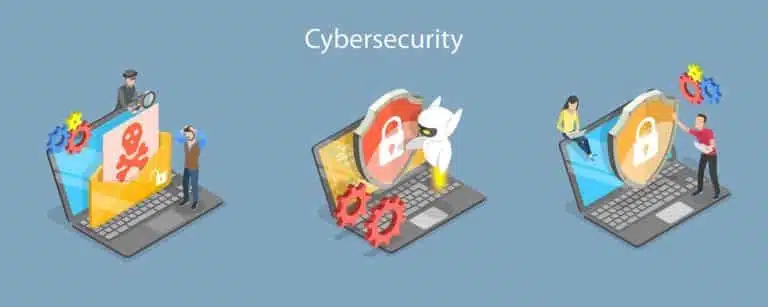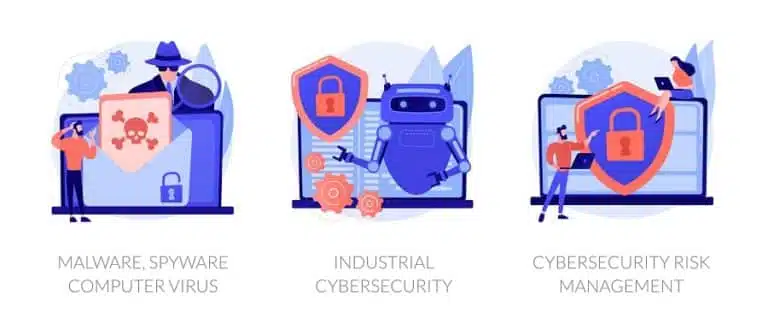Cyberattacks are a common threat to nearly every organization today. Dangers that were once only relevant to a limited number of industries now represent an equal threat to most organizations across industries. As more organizations grow to rely on cyberinfrastructure, the risk of a security breach becomes even more threatening, and the costs of experiencing an attack increase.
Organizations rely on collecting vast amounts of data and storing them throughout their digital environment. Still, while having a vast cyber network is essential for regular business operations, a more comprehensive network also opens the door to vulnerabilities that can be exploited by hackers and other criminals. At the same time, a growing market for stolen creates a tempting incentive for cybercriminals.
Despite the risk and growing investment in security solutions, cyberattacks still present a serious issue. Cyberattacks cost organizations an average of $4.24 million, discounting the indirect costs such as reputation and brand damage. The number of cyberattacks continues to increase, with a University of Maryland study showing that, on average, an attack occurs every 39 seconds. With this sobering statistic in mind, it’s not surprising organizations are prepared to do whatever they can to prevent attacks and keep their data safe. Despite the best of intentions, the realm of cyber risk management can become overwhelming, and it isn’t easy to know where to begin.
In this post, we break down all the essential information you need to know and take a look at:
- The definition of cyber risk
- Common forms of Cyber Risk
- What risks threaten organizations and how to identify them
- The legal requirements of cyber risk management
- How you can reduce cyber risk and manage risks with confidence
- Resources you can use on your cyber risk management journey
Keep reading to learn more about cyber risk and how you can prevent it from impacting your organization.

What Is Cyber Risk?
Cyber risk can be defined as the potential risk of an attack exposing an organization’s data or cyber systems to a cybercriminal, external elements, or circumstances that put the information or technology at risk of loss or damage. Risk implies the chance of a harmful event occurring, so cyber risks are the harmful events that threaten your organization’s cyber landscape. These risks come in many shapes and sizes and can originate internally from your system and employees or externally from criminals. Some of the most common examples of cyber risk include:
Common forms of Cyber Risk
1. Ransomware Data Leaks
Ransomware is a form of malware that encrypts computer data and blocks users from accessing it until they agree to pay the perpetrator a ransom. Ransoms are generally paid in digital currency to make it harder for law enforcement to track the currency and apprehend the criminal.
2. Phishing Malware
Phishing malware is when phishing techniques are used to inject malware into a device or network. Phishing is a form of cybercrime in which a target is directly contacted via text, telephone, or, most commonly, email by someone posing as a contact or legitimate institution and attempting to trick the individual into downloading malware posing as a legitimate attachment.
3. Insider threats
Insider threats are exactly what they sound like – a danger that threatens an organization from within, such as employees. This can be due to maliciousness or negligence, but any insiders with access to information can pose a risk, including current and former employees, contractors, or even business partners. The threat generally involves the sharing or exposure of sensitive information, but it can also include access to sensitive networks, sharing of trade secrets, security sabotage, or misconfiguration of networks that lead to data leaks.
4. Cyberattacks
‘Cyberattack’ is a broad term used to refer to any attempt to gain generally illegal or unlawful access to a device or network, especially for the purpose of causing damage or harm. This includes traditional hacking attacks, phishing, malware, and other techniques cybercriminals use to illegally access devices, networks, and information.
Cyber risk has far-reaching impacts on your organization, even outside of your cyber operations, and in addition to the potential downtime or halted operations to implement damage control protocols. The direct effects are often easy to spot and include the financial fallout of a breach. This sets back general business goals and can add up to the point where it even puts some organizations at risk of bankruptcy due to management expenses, legal fees, and regulatory fines (more on this later).
The indirect effects are harder to quantify but can also affect your organization’s general performance. These impacts include loss of customer trust and damage to brand reputation, which can significantly harm your organization. This effect can dissipate within months or last for years. Either way, the damage to your organization will leave a significant impact.
How to Identify Cyber Risks?
With cyber risk affecting all areas of business operations, recognizing and managing risk is critical. Here are a few techniques you can use to seek out and identify risks before they have the opportunity to damage your organization:
Identifying assets
To determine the exposure risk, you first need to identify the assets you want to protect. This isn’t as easy as it seems at first glance. You can’t protect all your assets equally, so once you have identified your assets, you will also need to prioritize them for protection. Some questions you can use to identify high-priority assets include asking:
- What types of data does your organization store?
- Who does the data belong to?
- What are the consequences of losing the data?
The last question involves several considerations, including how the data loss would affect the original owners, the business’s reputation, and, most importantly, whether it would result in legal action and fines involved in a failure to comply with data security regulations.
Another vital factor to consider is what would happen in case the data was accessed in any way. For example, what would the consequences be if the data was publicized, falsified, or made inaccessible? In the case of a credit card number, any or all of these scenarios could be disastrous, but some types of information are only affected by one or two of these issues.
Asking these questions helps determine which assets to prioritize for protection by showing the consequences that would result if the data were compromised. The next step is to understand who might compromise the data.
Identifying threats
Another facet of recognizing cyber risks involves identifying the sources that may potentially harm the assets you’ve identified for protection. While there are explicit threats such as hacking, when considering what may threaten data, it’s essential to think outside the box, which includes considering environmental factors, such as flooding, which may cause hardware damage. You need to examine your situation and determine which, if any, environmental factors present a potential risk to your assets.
Business threats such as equipment failure may also present a risk to your data, and even more tangentially, supply chains may prove to be a danger. Security professionals are growing increasingly aware of the dangers presented by suppliers who may take advantage of their connection to deliver malware to your system, whether accidentally through negligence or with malicious intent.
Insider threats from current or former employees can also threaten data due to their unique ability to access your networks as an insider. While not all these threats are directly related to cybersecurity, acknowledging the threats and developing mitigation plans ensures that your data remains safe. Even within the realm of cybersecurity, it’s important to distinguish between different threats, such as traditional hacking vs. phishing. Understanding the risks to your data will help you build an effective defense against them.
Identifying vulnerabilities
Once you’ve identified the risks that threaten your assets, you have to analyze your cybersecurity environment and identify its weaknesses that may leave you vulnerable to those threats. It’s not always easy to spot weaknesses or identify their origin. For example, how do you know if you are vulnerable to insider threats? Upsetting an employee in charge of sensitive data certainly increases your risk, but you can’t be sure. You may also be made vulnerable by employees making mistakes inadvertently or through a lack of education and awareness. Your employees may be using weak passwords or opening malicious attachments from emails that seem legitimate to the untrained eye.

Standards and Frameworks
In addition to the usual due diligence that is required to protect your organization’s reputation and general assets, there are also standards and frameworks in place that provide guidelines on how to manage cyber risk effectively. These include:
NIST
The NIST (National Institute of Standards and Technology) issued its Framework for Improving Critical Infrastructure Cybersecurity in 2014. The framework serves as a handy set of guidelines that delineates some of the steps organizations can take to protect themselves from cyberattacks. The guidelines aren’t legal requirements but rather a recommendation for an organizational approach to analyzing your organization’s security status and determining a course of action. The steps it delineates are:
- Identify assets and keep an up-to-date inventory
- Identify the risks your assets face
- Prioritize risks to make effective resource allocation decisions
- Develop a detailed protocol for prevention, detection, response, and recovery
- Develop current and future target profiles that describe assets, risks, and measures to prevent them
- Develop a detailed plan of action so that managers and administrators know how to respond to issues
- Update all of the above steps to keep up with organizational changes
CAPEC
Common Attack Pattern Enumerations and Classifications (CAPEC™) offers organizations a publicly available catalog of commonly used attack patterns cybercriminals use to exploit vulnerabilities in applications, devices, and networks. The catalog includes the protective measures most organizations take against cybercriminals and how they work around these measures. The catalog looks at design patterns and how they apply in a destructive context by analyzing real-world examples of cyber exploitation and data breaches.
Each pattern offers users knowledge on how attacks are executed, giving unique insight and guidance into how to mitigate the attack. This is especially beneficial for those developing applications or working on enhancing, adding, or administrating cyber capabilities – through understanding the attack, they’ll know what measures to build into their program to prevent them.
ISO27001
ISO is an international standard that sets out security risk assessment requirements. The compliance framework requires organizations to demonstrate proof of information security risk management, risk actions taken, and if relevant controls have been applied. The standard takes a best-practice approach to security and considers all aspects, including the people, processes, and technology involved.
How to Reduce Cyber Risk?
While creating plans to resolve cyberattacks is a necessary precaution, ideally, it is better to prevent the risk of an attack before it has the chance to occur. That’s why we’re breaking down some of the best ways you can reduce the risk to your cyber assets. These techniques include:
Identify and prioritize assets
To begin reducing the risks your assets face, you first need to determine what needs protection. This means combing through your network and identifying any data that may be vulnerable to attack. An excellent way to determine what data is at risk is by considering the consequences of losing the data. If the consequences are severe, the data is more likely to be valuable and therefore tempting to cyber attackers. Additionally, where the data is stored and how it is accessed (including by whom) helps identify data at risk. Once you have identified your highest risk and highest priority assets, you will have a clear idea of where to channel the majority of your security resources.
Identify potential cyber threats and vulnerabilities
The next step is to identify the threats that put your assets at risk. Identifying and learning about external threats is extremely important, but recognizing internal vulnerabilities is just as critical. One of the most common causes of internal vulnerabilities is employee ignorance and error. An IBM study revealed that human error is behind 23% of data breaches. Alternatively, breaches can be due to weaknesses in your supply chain or simply inherent to your code.
Educating employees can help mitigate the risk of error, and employees can also help identify risks within the system. External threats can also present extreme threats. Convincing phishing attacks or powerful malware injections can result in your network being breached. Once again, employee education can help mitigate the issue by teaching employees what emails and risks to avoid and helping them spot suspicious activity.
Analyze existing security controls and where the gaps are
Although you may invest a lot of time, energy, and money into your organization’s cybersecurity measures, no system is foolproof, and analyzing existing infrastructure for vulnerabilities can help identify gaps or previously overlooked vulnerabilities. Using a security framework such as those mentioned above as a guideline can help identify where your system is up to scratch and where there’s still room for improvements. Evaluating the people and technologies involved in your security process can also uncover previously unsuspected vulnerabilities. Lastly, the most critical step is to gather and analyze the data from your system, as even the most minor anomalies could indicate a more significant issue.
Implement policies, tools, and procedures
At this point in the process, you can once again use the frameworks mentioned above to help create mitigation policies to prevent cyber risk and attacks. Putting policies in place doesn’t only mean creating a strategy to implement in the event of a cyberattack but also what steps to take when a vulnerability or potential risk is spotted to prevent the danger from evolving into a full-blown breach. Other steps you can take to stop attacks include implementing security tools that scan your network and notify you of vulnerabilities, risks, or unusual activity that may indicate an attack.
Continuously monitor for new risks
Even if you feel your network is entirely secure now, hackers and other cybercriminals are constantly evolving their techniques to keep up with increasingly powerful security measures. Additionally, cybercriminals are well-known for adopting new technology early and using it for nefarious purposes. For example, hackers are already using AI capabilities to conduct more sophisticated phishing attacks. In light of these facts, a complacency is never an option, and it is essential to remain continually aware and constantly monitor your system. Constant monitoring is an unrealistic expectation for a human team, so implementing monitoring tools that alert you to the presence of risks can help ensure you’re constantly on top of your organization’s security situation.

Resources for Managing Cyber Risk
Want to learn more about managing cyber risks? Here are a few resources you can use to put your risk management plan into action:
Top 12 Cyber Risk Management Platforms
Monitoring and managing the constant threats that loom over your cyber landscape is overwhelming, exhausting, and close to impossible. Utilizing technological solutions and platforms that will automatically monitor your network, identify risks, and alert you to danger allows you to mitigate cyber risks before they become cyberattacks and it may even spot risks that could slip under your radar.
Thanks to growing demand, hundreds of platforms are available on the market. While this means you have a wide range of options and can find a platform that perfectly meets your organization’s needs, sifting through hundreds of platforms can become overwhelming. We broke it down into a short and easily digestible list of the best platforms available on the market today.
Cyber Security Risk Assessment Template [XLS download]
Assessing the risks your assets face is critical to building a mitigation and prevention strategy. But knowing where to begin combing your network for threats and vulnerabilities can be extremely challenging. While existing frameworks can help you understand the risks your organization faces and how to address them, they still don’t offer a guideline on how to conduct an effective assessment of your own network. In this download, we give you a clear and concise template that shows precisely how a risk assessment should be done.
What Is Cyber Supply Chain Risk Assessment and Why You Should Care
Most people are familiar with analyzing their own networks for risks and vulnerabilities. However, recently, the cybersecurity community has begun to take notice of a new avenue of threats that can be used to access your network and devices – third-party suppliers. Suppliers can, either intentionally or unintentionally, through negligence, allow malware, spyware, or outside forces to access your network by taking advantage of their unique access to your assets. Keeping track of suppliers can be complex, and threats can hide even deeper within the supply chain. For example, they may come from your suppliers’ suppliers. With risks continuing to appear from new and unexpected sources, monitoring and assessing your supply chain is more critical than ever before.
Manage Your Cyber Risks With Confidence
This guide introduces some of the most critical concepts that act as essential building blocks in your cyber risk management plans. In summary, here are a few proactive steps you can take to implement an effective cyber risk management plan:
- Scan your network and devices to identify your assets
- Keep an up-to-date catalog of your assets and prioritize their protection by vulnerability
- Educate employees on cyber risks with security awareness training
- Analyze your network for existing vulnerabilities and potential threats
- Identify the threats that put your assets at risk and learn how they operate
- Determine your organization’s legal privacy requirements and ensure compliance with regulatory frameworks
- Implement the tools, procedures, and processes necessary to protect against attack
- Continue to monitor your cyber landscape for vulnerabilities and continue enhancing and upgrading your risk assessment strategy
Implement these techniques and watch your security standard soar as attacks, breaches, and suspicious behavior decrease, leaving your assets secure and untouched.
Explore CybeReady’s platform to learn how you can involve your whole team in your cyber risk management strategy.













